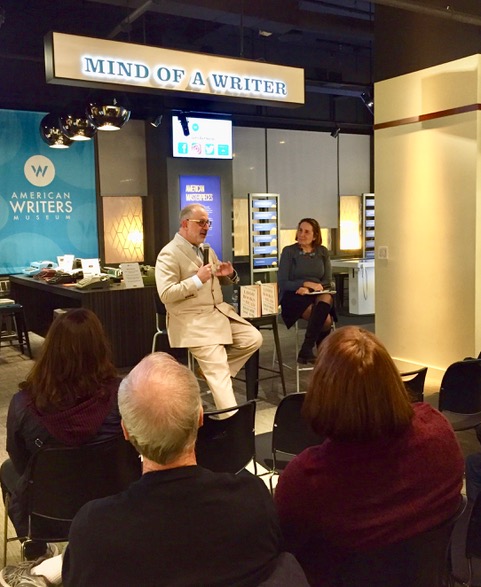Q&A: An Acclaimed Bookseller, on What 1,000 Books You Should Read Before You Die
/James Mustich began his career in bookselling at an independent bookstore in Briarcliff Manor, New York. After co-founding A Common Reader, an acclaimed mail-order book catalog, and running it for two decades, his unchecked bibliophilia led him to create a metaphorical bookshop in book form: 1000 Books to Read Before You Die (Workman Publishing). A reader with catholic enthusiasms, Mustich found a clue to the form of his book in the wisdom of the great writer and critic Edmund Wilson who praised “the miscellaneous learning of the bookstore, unorganized by any larger purpose, the undisciplined undirected curiosity of the indolent lover of reading.”
Mustich’s book is an invitation to conversation and debate, not a canon of the best or most important books. He has compiled a collection of great scope and diversity, and introduces each book with a short, deeply informed essay about the its particular magic. Mustich has an inspiring faith in the power of reading. “The right book at the right time can,” he says, “expand our lives in the way love does, making us more thoughtful, more generous, more brave, more alert to the world’s wonders and more pained by its inequities, more wise, more kind.” Mustich spoke with the National at the American Writers Museum in Chicago about 1000 Books to Read Before You Die.
Q: Let’s talk about your organization of this book. You made the brilliant decision which seems somehow both obvious and surprising: Alphabetically by author. How did you reach this decision?
A: The other possible frameworks—by chronology, by subject, by language of origin, by influence—seemed either boring or academic, siloing the titles in ways that stripped serendipity and surprise from the collection, and those are qualities that I wanted my volume to embody, if it could. They are the prime movers of a good bookshop. And when I saw that the alphabetical arrangement provided a way to position D’Arcy Wentworth Thompson On Growth and Form next to Flora Thompson’s Lark Rise to Candleford, and that lovely chronicle of English country life next to Hunter S. Thompson’s Fear and Loathing in Las Vegas, followed by Kay Thompson’s children’s book, Eloise at the Plaza, I knew I’d found the right formula.
Q: You go from A to Z, from Edward Abbey (“A Season in the Wilderness”) to Carl Zuckmayer (“A Part of Myself”) but how did you make decisions on which books to include? Your tastes are quite wide-ranging: on opposite pages, Cormac McCarthy’s Pulitzer Prize winning “The Road” faces children’s classic Robert McCloskey’s “Make Way for Ducklings.” So what was your measuring stick?
A: Engagement, memorability, narrative drive, stylish expression: I was after books that lingered in the mind and heart, or passed the time with such élan their delight was infectious and made one want to pass the book on to a friend. All of which also means I wanted books that other readers shared my appreciation of—something I knew about many of the books I included from my years as a bookseller, especially corresponding with customers when, some years ago now, I had my mail order catalog A Common Reader.
Q: A few authors do merit two books – Herman Melville (“Moby-Dick,” “The Piazza Tales”) and Philip Roth (“The Ghost Writer,” “American Pastoral”). How did you determine who got two books, and then which books were noted. For instance, why those Roth novels highlighted, rather than his famous “Goodbye, Columbus”?
A: I’m hesitant to ascribe too much methodical rigor to what is essentially a record of my own enthusiasms. Those authors with more than one book, Melville and Roth as you mention, but also Frances Hodgson Burnett and Doris Lessing, Virginia Woolf and Jane Austen, and a couple of dozen more, are those whose works I keep coming back to, discovering fresh facets or, frankly, just enjoying again and again. As for Roth, I chose The Ghost Writer and American Pastoral because the first has a lightness and grace that has stayed with me since I first read it, and the second an empathy, an attempt to understand intractable social and historical forces, that I found revelatory.
Q: How did you decide between sentimental favorites like Wallace Stegner’s “Crossing to Safety“ and his Pulitzer Prize winner “Angle of Repose.”?
A: I’ve always loved Angle of Repose. Only in the course of talking to people about my book have I discovered that there is an army of ardent admirers of Crossing to Safety, and they are passionately and articulately puzzled by my preference for the former over the latter.
Q: I can imagine that you had an easy time coming up with the first batch of books, but how did you approach filling in the rest, and did you think about balancing the book in any way?
A: As I write in the introduction, I believe that no matter their pedigree, inveterate readers read the way they eat: for pleasure as well as nourishment, indulgence as much as education Hot dogs one day, haute cuisine the next! Keeping such diversity of appetite in mind, and hoping to have something to satisfy every kind of reading yen, I wanted to make 1,000 Books to Read Before You Die expansive in its tastes, encompassing revered classics and commercial favorites, flights of escapist entertainment and enlightening works of erudition. I wanted people to open the book to look for a favorite, and then start coming upon other books or authors that intrigued them, or caught their fancy.
Q: You spent years encouraging others to read as a bookseller and with A Common Reader. How did those experiences inform how you thought about this book?
A: I still have eight large filing cabinets in my basement that are filled with the correspondence of customers of A Common Reader customers—thanking us for a discovery our writing about a book had prompted them to make, disagreeing with our choices, suggesting other titles and authors we hadn’t gotten to yet with a polite evangelism that was both gratifying and inspiring. I wanted to infuse my book with something of that spirit of discovery and shared delight.
Q: In retrospect, are there any books and authors you just couldn’t include but wish you could have included?
A: Too many to list. In the A’s alone: Aesop and Abelard, Hannah Arendt, W. H Auden and Anna Akhmatova, Sholem Aleichem and Sholem Asch, Nelson Algren and Monica Ali, Jorge Amado and Nadeem Aslam, Stephen E. Ambrose and Rick Atkinson, Kate Atkinson, Ariosto, Leila Aboulela, Louis Agassiz—you get the idea. I spent fourteen years writing this book, and there are days when I feel like a slacker.
Q: What part does whimsy play in one’s selection of a book to read, and do recommendations matter? And how do you decide what to read?
A: The bookseller John Saumerez Smith, for decades the guiding light of London’s Heywood Hill bookstore, once said that a bookshop should be a place of discovery, where you come upon things that, in the back of your mind, you knew you always wanted. Books swim up from deep depths of culture and commerce to land in our boats, so to speak, and recognizing them is a conjunction of whimsy, luck, and alertness.












